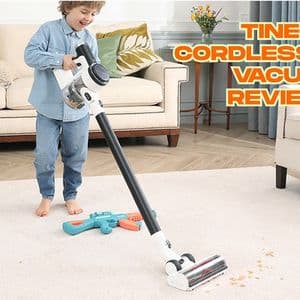Understanding Cordless Battery Vacuum Technology
So, how do these vacuums work?
Cordless battery vacuum cleaners run on rechargeable lithium-ion or nickel-metal hydride batteries. Lithium-ion batteries are more common due to their lighter weight, higher energy density, and faster charging times. These vacuums use compact yet powerful motors to create suction, while the battery provides consistent energy without needing a wall outlet.
The lack of a cord means fewer tripping hazards and a quicker setup. Users can simply grab the vacuum, press a button, and start cleaning—no need to plug or unplug between rooms. This ease of operation has made them a staple for people with busy lifestyles.
Advantages of Cordless Operation
Why do more households prefer going cordless?
The most obvious benefit is mobility. Without being tethered to an outlet, you can clean in hard-to-reach areas like high shelves, car interiors, or outdoor spaces. Many models also feature detachable designs, allowing them to function as hand held cordless vacuum cleaners for quick spot cleaning.
Cordless designs also make storage easier. Most can be mounted on a wall or tucked into a small closet, eliminating the need for large storage space. For apartment dwellers or homes with limited room, this is a clear advantage.
Battery Performance and Runtime
Here’s where technology matters most.
Battery performance determines how long you can clean before needing a recharge. On average, cordless battery vacuum cleaners offer 20 to 60 minutes of runtime, depending on suction mode and motor size. Eco modes can extend runtime, while high-power settings drain the battery faster.
Charging times vary—some models recharge in as little as three hours, while others take longer. Users should consider whether quick charging is important for their cleaning habits. Additionally, many newer designs include removable batteries, allowing users to swap in a fully charged pack for uninterrupted cleaning.
Suction Power and Cleaning Efficiency
Now, let’s talk about cleaning performance.
Cordless vacuums are often compared to traditional corded models in terms of suction. While older versions lagged behind, modern devices have closed the gap significantly. Advanced brushless motors deliver high RPMs with less energy loss, meaning strong suction for dust, pet hair, and debris.
Many models include multiple cleaning modes. This lets users adjust suction based on the surface—low power for hardwood floors, high power for carpets. A vacuum handheld cordless unit, when combined with the right nozzle, can effectively clean delicate upholstery or curtains without causing damage.
Filtration Systems and Allergen Control
Here’s something many overlook.
Filtration plays a vital role in maintaining indoor air quality. Many cordless battery vacuum cleaners now feature HEPA filters, which can trap up to 99.97% of particles as small as 0.3 microns. This is especially important for households with allergy sufferers or pets.
Washable filters make maintenance easier, reducing the cost of replacements. However, they require regular cleaning to prevent performance drops. A clogged filter can limit suction and shorten battery life, so upkeep is essential.
Attachments and Versatility
Think one vacuum fits all tasks? Not quite.
Cordless vacuums often come with various attachments—crevice tools, dusting brushes, and motorized mini-brushes. These accessories allow for specialized cleaning, from narrow spaces between furniture to stubborn pet hair on sofas.
Some designs convert seamlessly into smaller, portable units. This adaptability makes them useful for both quick cleanups and more thorough cleaning sessions, depending on your needs and schedule.
Noise Levels and User Comfort
Nobody enjoys a loud vacuum.
Cordless battery models generally run quieter than traditional vacuums, thanks to efficient motor designs and better sound insulation. Reduced noise not only makes cleaning less disruptive but also allows for flexible cleaning times, even early in the morning or late at night.
Lightweight construction and ergonomic handles reduce strain during use. This is particularly beneficial for elderly users or those with limited mobility, who may find heavier vacuums challenging to maneuver.
Environmental Considerations
Thinking about sustainability?
Battery-powered vacuums can reduce energy consumption compared to constantly running high-wattage corded units. Some manufacturers also design batteries for long life cycles, reducing waste. Additionally, washable filters and reusable dust bins minimize reliance on disposable vacuum bags.
For those seeking the best battery vacuum in terms of eco-friendliness, checking for recyclable materials and long-term battery performance is key. Responsible disposal of old batteries also plays an important role in environmental care.
Choosing the Right Cordless Battery Vacuum Cleaner
So, what should you look for?
When selecting a cordless model, consider your home’s flooring types, cleaning frequency, and storage space. Battery life, suction power, weight, and included accessories all influence how well the vacuum will meet your needs.
It’s also worth noting that no single model is perfect for everyone. A compact design might be ideal for a small apartment, while a larger model with a bigger dust bin suits larger homes with pets. The goal is to match features to your lifestyle, ensuring the vacuum works with—not against—your cleaning habits.
Final Thoughts
Cordless battery vacuum cleaners have transformed the way households approach cleaning. They combine mobility, efficiency, and user-friendly designs to deliver a more flexible cleaning experience. While factors like battery life and suction power vary between models, understanding the technology and available features helps ensure you choose a vacuum that suits your home.
As battery technology continues to advance, these devices are likely to become even more powerful and long-lasting. For anyone seeking a balance between performance and convenience, cordless designs are proving to be a modern cleaning essential.










